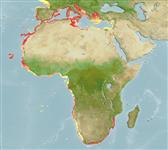Classification / Names
Common names from other countries
Main reference
Size / Weight / Age
Max length : 55.0 cm TL male/unsexed; (Ref. 3397); common length : 30.0 cm TL male/unsexed; (Ref. 3688); max. reported age: 12 years (Ref. 13716)
Length at first maturity
Lm 18.8, range 20 - ? cm
Environment
Marine; brackish; demersal; depth range 0 - 150 m (Ref. 3688), usually 10 - 20 m (Ref. 37413)
Climate / Range
Subtropical, preferred 23°C (Ref. 107945); 48°N - 35°S, 25°W - 36°E
Distribution
Eastern Atlantic: Bay of Biscay, Strait of Gibraltar and Mediterranean; southward to Cape of Good Hope, South Africa; around the Canary and Cape Verde Islands (Ref. 3688); and Madeira Is (Ref. 74541). Western Indian Ocean: southern Mozambique (Ref. 3688). Not found in tropical east Africa (Ref. 3198), Red Sea (Ref. 84159) and Black Sea (Ref. 4781, 112870).
Countries | FAO areas | Ecosystems | Occurrences | Introductions
Short description
IUCN Red List Status (Ref. 115185)
Threat to humans
Harmless
Human uses
Fisheries: minor commercial; gamefish: yes
More information
ReferencesAquacultureAquaculture profileStrainsGeneticsAllele frequenciesHeritabilityDiseasesProcessingMass conversion
Tools
Special reports
Download XML
Internet sources
Estimates of some properties based on models
Phylogenetic diversity index
PD50 = 0.5625 many relatives (e.g. carps) 0.5 - 2.0 few relatives (e.g. lungfishes)
Trophic Level
3.4 ±0.50 se; Based on food items.
Resilience
Medium, minimum population doubling time 1.4 - 4.4 years (K=0.24; tm=2)
Vulnerability
Moderate vulnerability (40 of 100)
Price category
